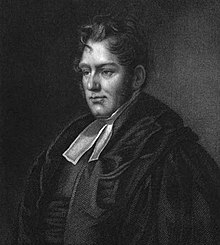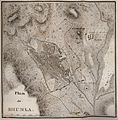Robert Walsh
Reverend Robert Walsh (* 1772 in Waterford , † June 30, 1852 in Kilbride , County Wicklow ) was an Irish-British cleric and writer.
life and work
Walsh studied at Trinity College in Dublin from November 1789, where he became acquainted with the Irish nationalist Robert Emmet and the poet Thomas Moore . He graduated with a BA in 1796 . The last years of the 18th century in Ireland were overshadowed by repeated revolts against British rule over Ireland, particularly in the years 1796 to 1798 ; the following Act of Union (1800) then even unified the two kingdoms of Ireland and Great Britain and abolished the Irish Parliament. Nothing more is known about Walsh's attitude during this period.
After Walsh was ordained a cleric in the Anglican Church of Ireland , he served from 1806 to 1820 as an assistant pastor in Finglas ( County Dublin ), now a district of Dublin . During this time he also married Anne, the daughter of John Bayly. Together with John Warburton and Rev. James Whitelaw (1749–1813) he wrote a city history of Dublin in two volumes, which, however, was not published until 1818 - after the death of both co-authors! - has been published. During his years in Finglas, Walsh also worked as a local archaeologist and made several important discoveries; Not to forget, too, that in 1828 he published a highly regarded treatise on ancient coins and medallions.
His life took a new turn when in 1820 he was appointed chaplain of the British Embassy, first in St. Petersburg and then in Constantinople . His aptitude for this position was perhaps due to his book An Account of the Levant Company , published in 1825 and dedicated to the President of the Levant Company , Lord Grenville ; perhaps his acquaintance with Grenville may also have been responsible for his calling. Walsh then stayed in Turkey for several years and did not return to England until 1827. He wrote a detailed account of his return trip, which soon after its publication attracted a lot of attention and was translated into several languages, including German. This account of Walsh's journey through European Turkey (today's Bulgaria ) became one of the most widely used books for anyone looking for up-to-date information on the eastern regions of the Balkan Peninsula . The fact that Walsh's travelogue appeared just in the year (1828), when the second Russo-Ottoman War of the 19th century broke out, made his book a much sought-after standard work overnight, because Walsh had crossed and described precisely the areas that were now affected by the war were haunted. Walsh's travelogue, however, is written from an openly anti-Turkish and Islamophobic perspective, which gives his descriptions a very subjective character.
In 1828 he was appointed the new chaplain of the British Embassy in Rio de Janeiro . He spent almost a year in Brazil, where he was particularly interested in the living and working conditions of the slaves. This resulted in his book Notices of Brazil in 1828 and 1829 , in which Walsh pleaded for the abolition of the slave trade. His efforts were not immediately successful, however, and it was not until 1850 that the importation of slaves into Brazil was banned; the institution of slavery as such was not abolished until 1888. Walsh left Brazil in May 1829 and reached England at Portsmouth on June 30th.
Walsh subsequently earned a degree in medicine and worked as a doctor for a short time. He again spent the years from 1831 to 1835 in Constantinople, in the same capacity as chaplain. From this second stay (after his return from Turkey) the two-volume books A Residence at Constantinople (1836) and Constantinople and the Scenery of the Seven Churches of Asia Minor Illustrated (1839) went. The latter two illustrated volumes bring together numerous lithographs created by the British architect and landscape painter Thomas Allom (1804–1872) (see below: gallery), each of which is accompanied and explained by a text by Walsh. Many of these illustrations became very popular and both reproduced in other works and sold as individual prints.
Walsh returned to Ireland in 1835. In 1839 he changed his place of residence in Finglas to a new job in Kilbride, where he lived until his death.
gallery
Fonts
- 1818 (with J. Warburton & J. Whitelaw): History of the City of Dublin, from the Earliest Accounts to the Present Time; Containing its Annals, Antiquities, Ecclesiastical History, and Charters; its Present Extent, Public Buildings, Schools, Institutions, & c. To which are Added, Biographical Notices of Eminent Men, and Copious Appendices of its Population, Revenue, Commerce, and Literature . 2 volumes. London: T. Cadell and W. Davies (Google: Volume I - Volume II )
- 1825 (anonymous): An Account of the Levant Company; with Some Notices of the Benefits Conferred upon Society by its Officers, in Promoting the Cause of Humanity, Literature, and the Fine Arts; & c. & c. London: J. and A. Arch; Hatchard and Son ( Google )
- 1828: Narrative of a Journey from Constantinople to England . London: Frederick Westley and AH Davis ( Google ≈ archive )
- Second edition 1828: Narrative of a Journey from Constantinople to England. Second edition . London: Frederick Westley and AH Davis ( Google )
- American edition 1828: Narrative of a Journey from Constantinople to England . Philadelphia: Carey, Lea & Carey ( Google )
- German edition 1828: Journey from Constantinople through Rumelia, the Balkan Mountains, Bulgaria, Wallachia, Transylvania and Hungary. A contribution to the latest customer of the Turkish Empire. Translated from English by Wilhelm Adolf Lindau . 2 parts. Dresden - Leipzig: Arnoldische Buchhandlung (Google: Part I - Part II )
- French edition 1828: Voyage en Turquie et à Constantinople, by R. Walsh, attaché a l'ambassade de Lord Strangford; Traduit de l'anglais par H. Vilman and E. Hives . Paris: Moutardier ( Google ≈ archive )
- Dutch edition 1829: Reis van Konstantinopel, door Turkije, Walachje, Transilvanie en Hongarije, naar Duitschland. Uit het Engelsch vertaald. Met cards en platen. Amsterdam: GJA Beijerinck ( Google )
- 1828: An Essay on Ancient Coins, Medals, and Gems, as Illustrating the Progress of Christianity in the Early Ages. Second Edition Greatly Enlarged . London: Howell and Stewart ( Google ≈ archive )
- 1830: Notices of Brazil in 1828 and 1829 . 2 volumes. London: Frederick Westley and AH Davis (Google: Volume I - Volume II )
- 1836: A Residence at Constantinople, during a Period Including the Commencement, Progress, and Termination of the Greek and Turkish Revolutions . 2 volumes. London: Frederick Westley and AH Davis (Google: Volume I - Volume II )
- 1839 (together with Thomas Allom): Constantinople and the Scenery of the Seven Churches of Asia Minor Illustrated. In a Series of Drawings from Nature by Thomas Allom. With an Historical Account of Constantinople, and Descriptions of the Plates, by the Rev. Robert Walsh. 2 volumes. London: Fisher, Son, & Co. (Google: Volume I - Volume II ) (archive Farbscan: Volume I - Volume II )
Web links
Individual evidence
- ↑ See also: List of Scholars of Trinity College Dublin. Retrieved November 12, 2019 .
- ↑ Grit Eggerichs: The end of slavery in Brazil. Deutschlandfunk, May 13, 2018, accessed on November 12, 2019 .
- ↑ David Wilson: List of British Consular Officials in the Ottoman Empire and its former territories, from the sixteenth century to about 1860. July 2011, accessed on November 12, 2019 (English).
- ^ List of chaplains of the Levant Company. English Wikipedia, accessed November 12, 2019 .
- ↑ The volumes are not dated; the usual date is 1839, but different dates (1836/38 or 1840) are also given.
| personal data | |
|---|---|
| SURNAME | Walsh, Robert |
| ALTERNATIVE NAMES | Walsh, Reverend Robert (full name) |
| BRIEF DESCRIPTION | Irish-British cleric and writer |
| DATE OF BIRTH | 1772 |
| PLACE OF BIRTH | Waterford |
| DATE OF DEATH | June 30, 1852 |
| Place of death | Kilbride , County Wicklow |







